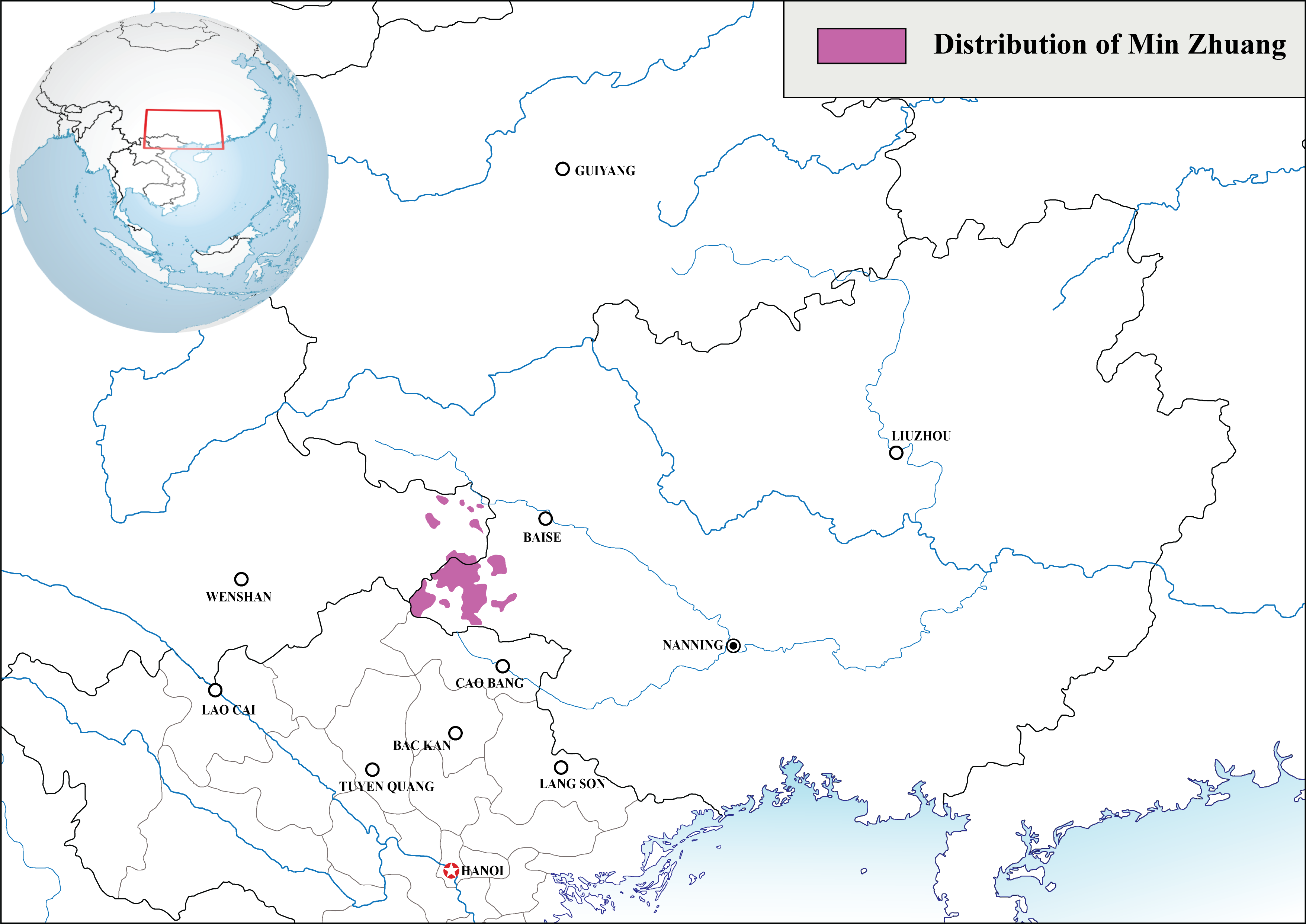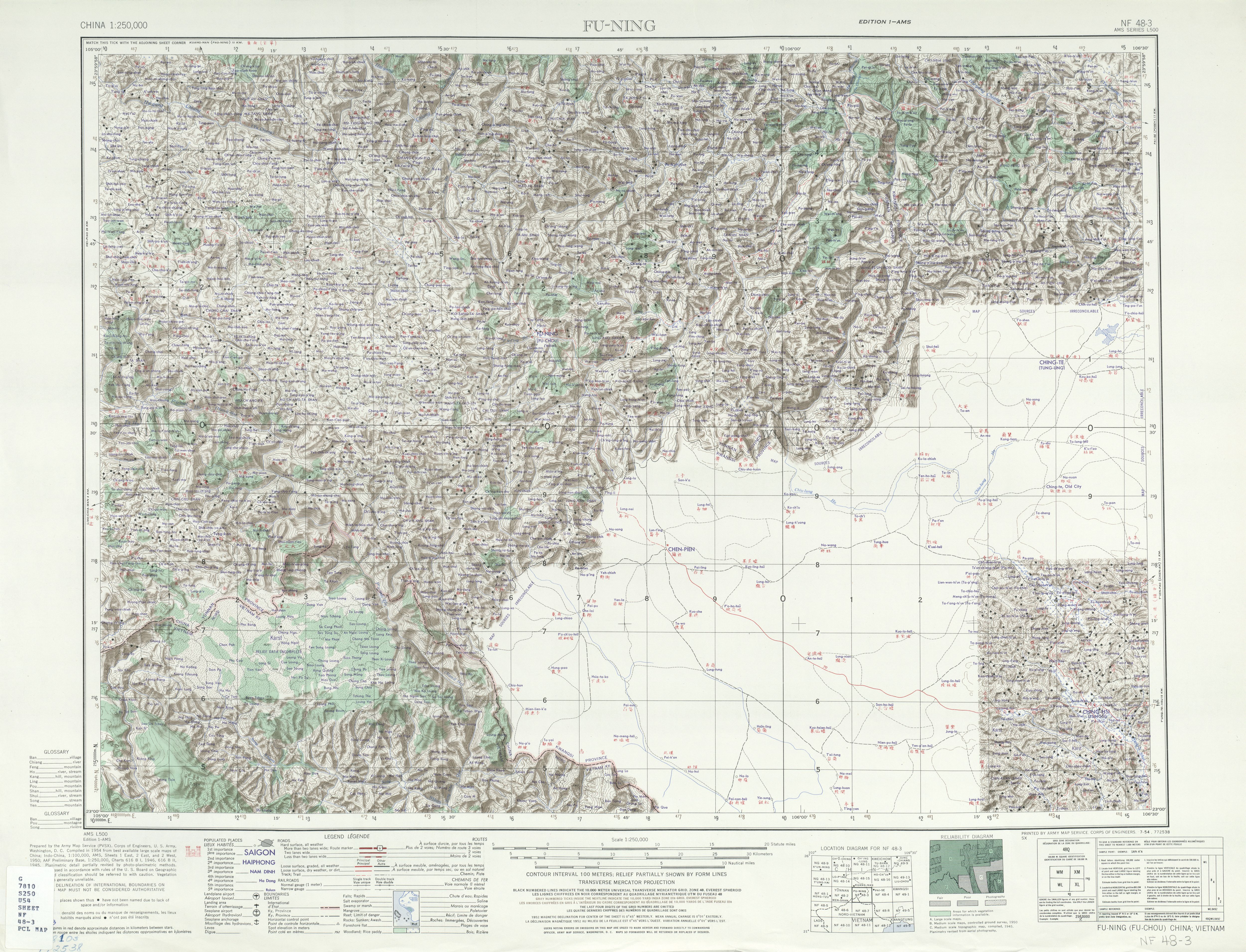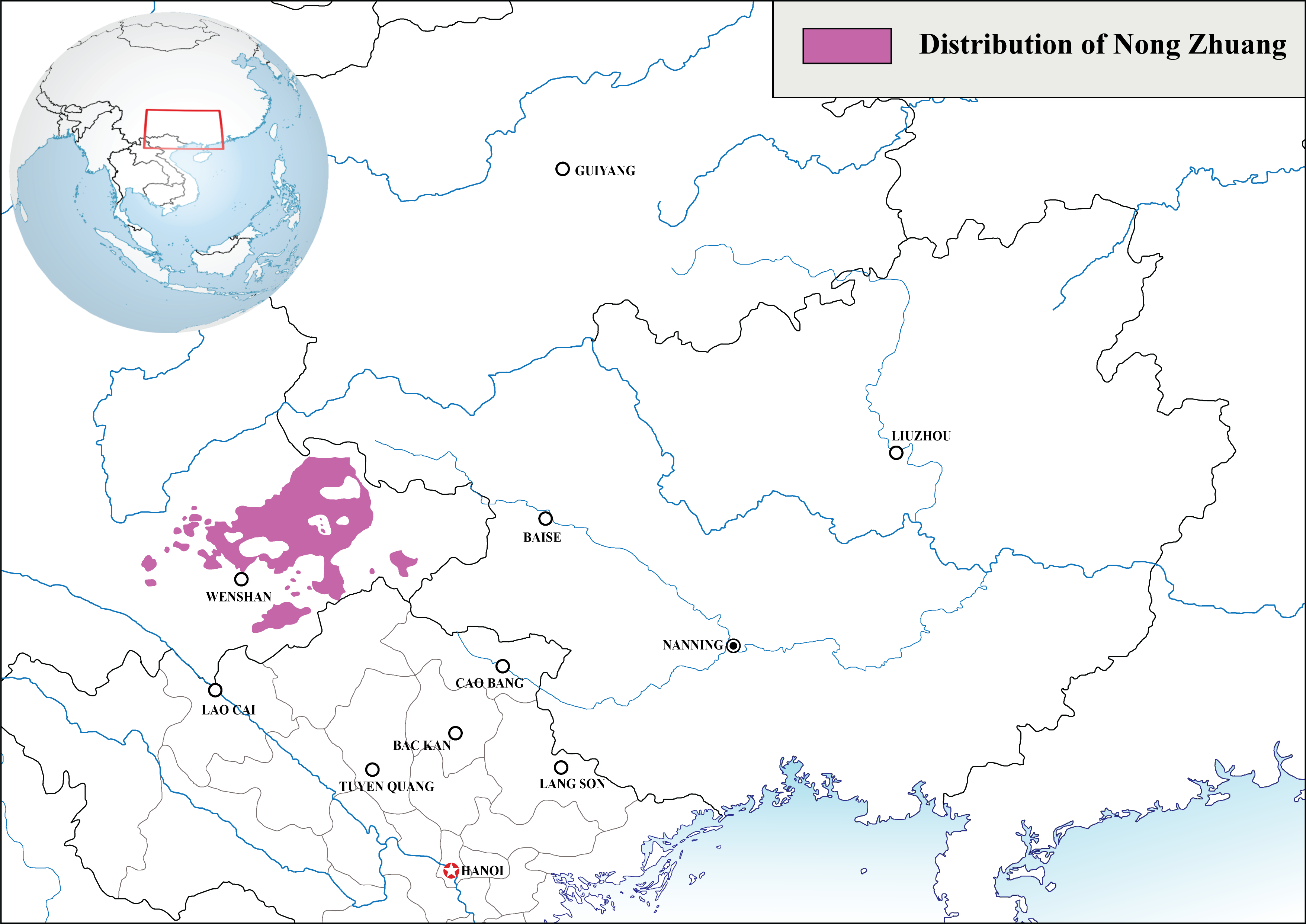|
Min Zhuang Language
Min Zhuang is a recently described Tai language spoken in the Langheng (郎恒) area of Funing County, Yunnan, China, and possibly also southwestern Guangxi province. All speakers are reportedly bilingual in Yei Zhuang (also known as Guibian Zhuang or Sha), which is classified as Northern Tai (Johnson 2011a). The language was first described in 2011 by Eric C. Johnson of SIL International, though it had been earlier mentioned in Kullavanijaya and L-Thongkum (1998). Names The Min Zhuang speakers of Guixun-Anhe call their language ' or '. Another Min Zhuang dialect is called ' or '. Classification Johnson (2011b) reported Min Zhuang to share many features with Nong Zhuang, a Central Tai language. However, it is unintelligible with the more widely spoken Nong Zhuang, Yei Zhuang, and Dai Zhuang languages. Distribution Min Zhuang is spoken by about 2,600 people in 11 villages. With the exception of Shangmabu (上麻布), all of the following villages are purely made up of Min Zhu ... [...More Info...] [...Related Items...] OR: [Wikipedia] [Google] [Baidu] |
China
China, officially the People's Republic of China (PRC), is a country in East Asia. It is the world's most populous country, with a population exceeding 1.4 billion, slightly ahead of India. China spans the equivalent of five time zones and borders fourteen countries by land, the most of any country in the world, tied with Russia. Covering an area of approximately , it is the world's third largest country by total land area. The country consists of 22 provinces, five autonomous regions, four municipalities, and two Special Administrative Regions (Hong Kong and Macau). The national capital is Beijing, and the most populous city and financial center is Shanghai. Modern Chinese trace their origins to a cradle of civilization in the fertile basin of the Yellow River in the North China Plain. The semi-legendary Xia dynasty in the 21st century BCE and the well-attested Shang and Zhou dynasties developed a bureaucratic political system to serve hereditary monarchies, or dyna ... [...More Info...] [...Related Items...] OR: [Wikipedia] [Google] [Baidu] |
Funing County, Yunnan
Funing County (; Zhuang language: ) is located in Wenshan Zhuang and Miao Autonomous Prefecture, in the east of Yunnan province, China. It is the easternmost county-level division of Yunnan, bordering Guangxi to the north, east and southeast, and Vietnam's Hà Giang Province to the south. Administrative divisions In the present, Funing County has 6 towns, 6 townships and 1 ethnic township. ;6 towns ;6 townships ;1 ethnic township * Dongbo Yao () Ethnic groups Ethnic groups of Funing County include the following. Population statistics are from 1990, and are sourced from the ''Funing County Ethnic Gazetteer'' (1998). *Han Chinese (84,337 people) *Zhuang people (199,784 people, including the Buyang) ** Min ZhuangJohnson, Eric C. 2011.A Lexical and Phonological Comparison of the Central Taic Languages of Wenshan Prefecture, China: Getting More Out of Language Survey Wordlists Than Just Lexical Similarity Percentages. SIL Electronic Working Papers 2011-005: 170. ** Dai Zhuang (" ... [...More Info...] [...Related Items...] OR: [Wikipedia] [Google] [Baidu] |
Tai Languages
The Tai or Zhuang–Tai languages ( th, ภาษาไท or , transliteration: or ) are a branch of the Kra–Dai language family. The Tai languages include the most widely spoken of the Tai–Kadai languages, including Standard Thai or Siamese, the national language of Thailand; Lao or Laotian, the national language of Laos; Myanmar's Shan language; and Zhuang, a major language in the Southwestern China's Guangxi Zhuang Autonomous Region, spoken by the Zhuang (壯) people, the largest minority ethnic group in China, with a population of 15.55 million, living mainly in Guangxi, the rest scattered across Yunnan, Guangdong, Guizhou and Hunan provinces. Name Cognates with the name ''Tai'' (''Thai, Dai'', etc.) are used by speakers of many Tai languages. The term ''Tai'' is now well-established as the generic name in English. In his book '' The Tai-Kadai Languages'' Anthony Diller claims that Lao scholars he has met are not pleased with Lao being regarded as a Tai language. k� ... [...More Info...] [...Related Items...] OR: [Wikipedia] [Google] [Baidu] |
Central Tai Languages
The Central Tai languages include southern dialects of Zhuang, and various Nung and Tày dialects of northern Vietnam. Central Tai languages differ from Northern Tai languages in that Central Tai distinguishes unaspirated and aspirated onsets, while Northern Tai generally does not (Li 1977). Southwestern Tai also displays this kind of aspiration contrast. Classification William Gedney considers Central Tai to be more closely related to Southwestern Tai than to Northern Tai, while André-Georges Haudricourt argues for a closer relation to Northern Tai. Pittayaporn's (2009) tentative tree of the Tai branch, however, considers Central Tai to be paraphyletic. Certain languages in predominantly Central Tai-speaking areas, such as Caolan and Nùng An in northern Vietnam, display Northern Tai features as well. These appear to be mixed languages that are not fully Central Tai or Northern Tai. Jerold A. Edmondson calls Caolan a "tertium quid." Jerold Edmondson's (2014)Edmondson, ... [...More Info...] [...Related Items...] OR: [Wikipedia] [Google] [Baidu] |
Tai Language
The Tai or Zhuang–Tai languages ( th, ภาษาไท or , transliteration: or ) are a branch of the Kra–Dai language family. The Tai languages include the most widely spoken of the Tai–Kadai languages, including Standard Thai or Siamese, the national language of Thailand; Lao or Laotian, the national language of Laos; Myanmar's Shan language; and Zhuang, a major language in the Southwestern China's Guangxi Zhuang Autonomous Region, spoken by the Zhuang (壯) people, the largest minority ethnic group in China, with a population of 15.55 million, living mainly in Guangxi, the rest scattered across Yunnan, Guangdong, Guizhou and Hunan provinces. Name Cognates with the name ''Tai'' (''Thai, Dai'', etc.) are used by speakers of many Tai languages. The term ''Tai'' is now well-established as the generic name in English. In his book '' The Tai-Kadai Languages'' Anthony Diller claims that Lao scholars he has met are not pleased with Lao being regarded as a Tai language. ... [...More Info...] [...Related Items...] OR: [Wikipedia] [Google] [Baidu] |
Guangxi
Guangxi (; ; Chinese postal romanization, alternately romanized as Kwanghsi; ; za, Gvangjsih, italics=yes), officially the Guangxi Zhuang Autonomous Region (GZAR), is an Autonomous regions of China, autonomous region of the People's Republic of China, located in South China and bordering Vietnam (Hà Giang Province, Hà Giang, Cao Bằng Province, Cao Bằng, Lạng Sơn Province, Lạng Sơn, and Quảng Ninh Provinces) and the Gulf of Tonkin. Formerly a Provinces of China, province, Guangxi became an autonomous region in 1958. Its current capital is Nanning. Guangxi's location, in mountainous terrain in the far south of China, has placed it on the frontier of Chinese civilization throughout much of History of China, Chinese history. The current name "Guang" means "expanse" and has been associated with the region since the creation of Guang Prefecture in 226 AD. It was given Administrative divisions of the Yuan dynasty, provincial level status during the Yuan dynasty, but ev ... [...More Info...] [...Related Items...] OR: [Wikipedia] [Google] [Baidu] |
Yei Zhuang
Yei Zhuang is a Northern Tai language complex spoken in Wenshan Prefecture, Yunnan, China. Its speakers are also known as the Sha (沙族). Distribution In Yunnan, Yei Zhuang dialects are spoken in Funing and Guangnan counties (also in Guangxi to the east and north), as well as Qiubei (probably also in Qujing Municipality to the north). The largest concentrations of Yei Zhuang speakers are found in Qiubei (80% of total Zhuang population) and Funing (50% of total Zhuang population) counties (Johnson 2011a:43). Po-ai, a Tai language of Funing County described by Fang-kuei Li in the mid-1900s, was determined by Johnson (2011b) to be a Yei Zhuang dialect. Names Below are various names (both autonyms and exonyms) for speakers of Yei Zhuang (Johnson 2011a:43). *pu Nong (濮侬) * (Qiubei) *bu Yai (布雅衣) *bu Yei (布依, 布瑞, 布越) *Shazu (沙族) or Sharen (沙人) *Baisha (白沙) *Nongqianbeng (侬迁绷) *Zhongjia (仲家) Many of these are names of Bouyei as well. ... [...More Info...] [...Related Items...] OR: [Wikipedia] [Google] [Baidu] |
Northern Tai Languages
The Northern Tai languages are an established branch of the Tai languages of Southeast Asia. They include the northern Zhuang languages and Bouyei of China, Tai Mène of Laos and Yoy of Thailand. Languages Ethnologue ''Ethnologue'' distinguishes the following languages: * Saek (Laos and northeast Thailand; listed outside Tai proper in the ''Ethnologue'' classification, though said to be similar to Tai Maen, which is listed as Northern Tai) * Tai Maen (Laos) * Yoy (Thailand) * Bouyei (Buyi) (China) (including the language of the Giáy people of Vietnam) * Central Hongshuihe Zhuang * Eastern Hongshuihe Zhuang * Guibei Zhuang * Yei Zhuang * Lianshan Zhuang * Liujiang Zhuang * Liuqian Zhuang * Yongbei Zhuang * Youjiang Zhuang (See varieties of Zhuang.) Yoy is elsewhere classified as Southwestern Tai, and E, which is a mixed language Northern Tai-Chinese language. Longsang Zhuang, a recently described Northern Tai language, is spoken Longsang Township, Debao County, ... [...More Info...] [...Related Items...] OR: [Wikipedia] [Google] [Baidu] |
SIL International
SIL International (formerly known as the Summer Institute of Linguistics) is an evangelical Christian non-profit organization whose main purpose is to study, develop and document languages, especially those that are lesser-known, in order to expand linguistic knowledge, promote literacy, translate the Christian Bible into local languages, and aid minority language development. Based on its language documentation work, SIL publishes a database, ''Ethnologue'', of its research into the world's languages, and develops and publishes software programs for language documentation, such as FieldWorks Language Explorer (FLEx) and Lexique Pro. Its main offices in the United States are located at the International Linguistics Center in Dallas, Texas. History William Cameron Townsend, a Presbyterian minister, founded the organization in 1934, after undertaking a Christian mission with the Disciples of Christ among the Kaqchikel Maya people in Guatemala in the early 1930s.George Thomas ... [...More Info...] [...Related Items...] OR: [Wikipedia] [Google] [Baidu] |
Theraphan Luangthongkum
Professor Theraphan Luangthongkum (also cited variously as L-Thongkum, L. Thongkum or Thongkum in publications) is a Thai linguist, specializing in phonetics, linguistic fieldwork, lexicography and minority languages of Southeast Asia. She is currently a faculty member of the Department of Linguistics, the Faculty of Arts, Chulalongkorn University, Thailand. In 2010 she was awarded an honorary membership by the Linguistics Society of America, making her the first Thai linguist to receive this honor. Education Prof. Luangthongkum graduated from the Faculty of Arts, Chulalongkorn University in 1968 with a BA (2nd class honors) in English. She then went to the University of California at Davis, where she received her MA in Linguistics in 1970. With a scholarship from the Ford Foundation, she furthered her studies in phonetics at the University of Edinburgh, where she obtained her Ph.D. in 1977. Awards *Distinguished Researcher Award (Humanities), National Research Council of Thaila ... [...More Info...] [...Related Items...] OR: [Wikipedia] [Google] [Baidu] |
Nong Zhuang Language
Nong Zhuang () is a Tai language spoken mainly in Wenshan Prefecture, Yunnan, China. In Wenshan Prefecture, it is spoken in Yanshan, Guangnan, Wenshan, Maguan, Funing, Xichou, and Malipo counties, and also in Honghe Prefecture and Vietnam. The heaviest concentrations relative to other Zhuang groups are in Xichou (96% of the total Zhuang population) and Malipo (90% of the total Zhuang population) counties (Johnson 2011a:43). Names Below are various names (both autonyms and exonyms) for the Nong Zhuang people (Johnson 2011a:43). *Pu Nong (濮侬) * *Nongzu (侬族) or Nongren (侬人) *Long (龙) *Bu Tei *Bendi ( 'indigenous') Subdivisions Johnson (2011a) gives the following subdivisions for the Nong Zhuang peoples. *Dao Nong (道侬), or Nong Dau ('): Guangnan County *Niang Nong (仰侬), or Nong Nyeng ('); also called the "Green Nong" (青侬): along the Chouyang River (畴阳河) in Xichou and Malipo counties. *Du Nong (赌侬), or Nong Du ('): along the Duzhou River (赌咒河 ... [...More Info...] [...Related Items...] OR: [Wikipedia] [Google] [Baidu] |





